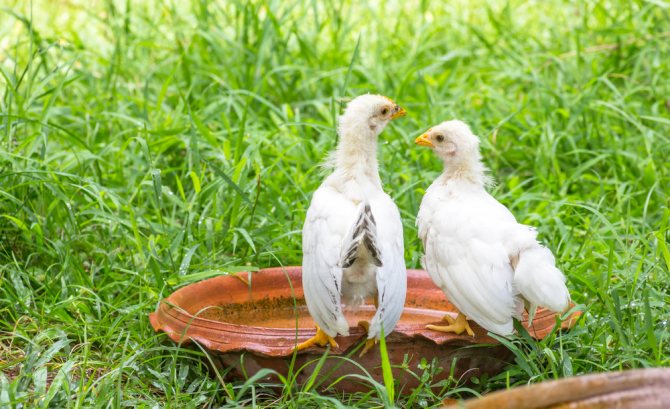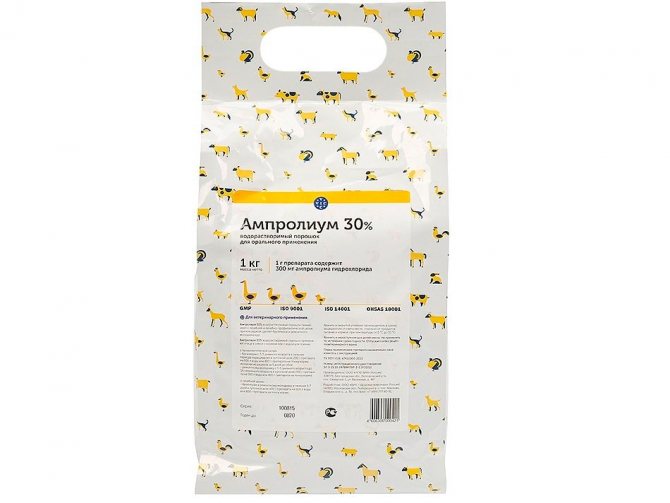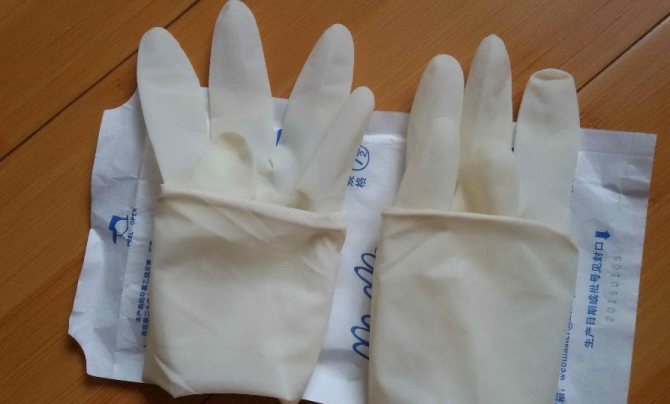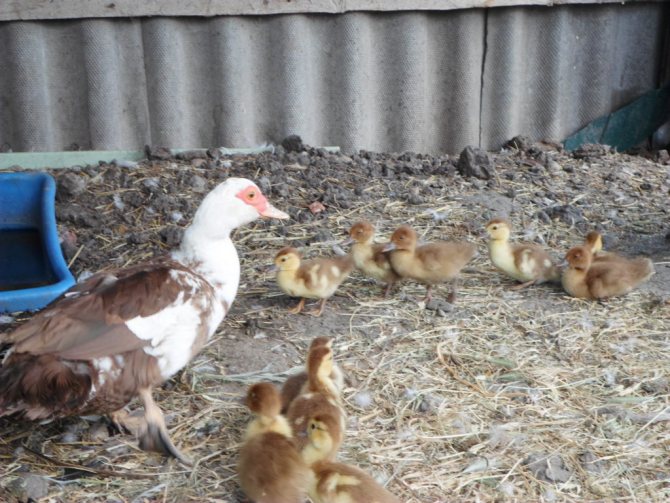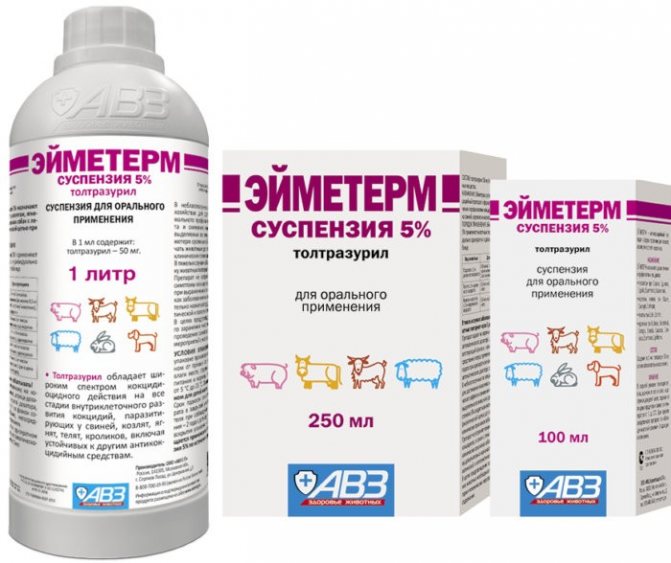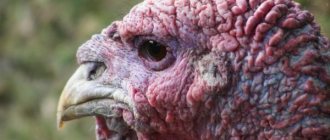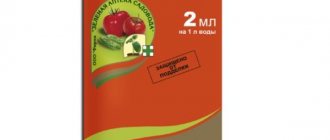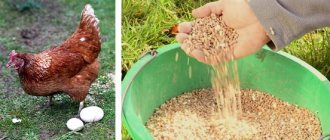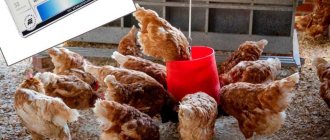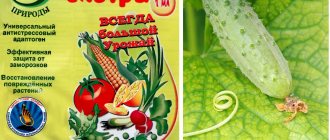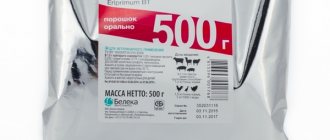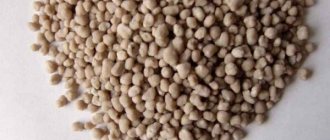Coccidiosis is a common and dangerous disease that often occurs in poultry and causes huge losses for farmers. To combat the disease, poultry farmers use the drug Amprolium, an effective agent that has a detrimental effect on coccidia and prevents the re-development of the disease. In addition to effectiveness, the main advantage of the drug is its safety, since the use of Amprolium does not affect the immune system and the protective functions of the body. Before using the medication, you should read the instructions.

Pharmacology of the drug and composition
The veterinary drug Amprolium is an anti-coccidial agent for poultry and livestock. It looks like a light or yellowish powder. The medicine is sold in plastic bags or plastic containers of different sizes.
1 g of powder contains 300 mg of amprolium hydrochloride. In addition, the preparation contains an auxiliary component - lactose. In veterinary medicine, it is used to treat poultry and farm animals from diseases provoked by coccidia.
The active component of the drug is similar in structure to thiamine - a substance that coccidia require for reproduction. After using the drug, amprolium hydrochloride replaces thiamine, which causes disturbances in carbohydrate metabolism in parasites and their death.
The use of small doses of Amprolium in order to prevent infection does not have a negative effect on birds, therefore, the agent is recognized as low-toxic.
About 97% of the medicine is excreted from the body of birds along with feces.
Pharmacological properties
Amprolium has the following properties:
- Has a broad anti-coccidial effect in relation to anti-coccidial parasites.
- The active functioning of amprolium hydrochloride lies in the close proximity of the chemical composition of the drug with thiamine, which is necessary for the life of coccidia. Amprolium has the best property of penetration into parasitic cells for settling in active centers of vitamin compounds. This allows you to damage carbohydrate metabolism and destroy the parasite.
- Non-toxic to birds, since the cell membrane of the intestinal membrane is impermeable to the active substances of amprolium.
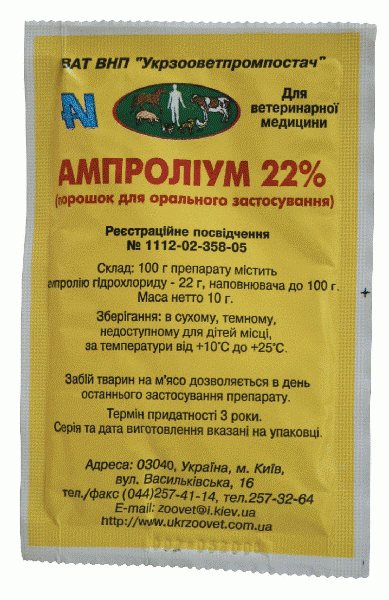

Amprolium 22%
- Amprolium hydrochloride leaves the bird's body with droppings almost completely.
- A drug contributes to the formation of strong immunity to further combat coccidia.
- Amprolium is considered a low-hazard substance., since it is not capable of exerting a strong toxic effect on the organism of animals.
The drug is most used to combat coccidiosis in birds and animalsbecause it has a number of advantages:
- Promotes fast getting rid of the signs of coccidiosis;
- Lack of side effects;
- Low toxic substance;
- Does not provoke addictive;
- Has no negative impact on the process of developing broiler immunity.
Indications and effectiveness
Veterinarians recommend using Amprolium to eliminate the following diseases:
- coccidiosis;
- eimeriosis;
- trematodosis;
- cestodosis.
The effectiveness of a medicine in the treatment of poultry depends on certain factors:
- the thermal regime and the level of humidity in the room where the birds live;
- conditions of detention, cleanliness, diet.
The effectiveness of the drug can be influenced by the type of coccidia and their susceptibility to the active component, the presence of other infections and pathologies.
What diseases is amprolium used for?
Amprolium hydrochloride, which is the active substance of this drug, helps to inhibit the growth of coccidial parasites. The drug is effective in schizogony of the first two generations.... Also, it should be noted that amprolium does not have any harmful and depressing effects on the immune system.
Major diseases, to which the action of the drug is directed, is:
- Coccidiosis;
- Aymeriosis;
- Cestosis;
- Trematodosis;
- Entomosis.


Amprolium powder
The success and effectiveness of the fight against coccidial parasites is depending on the quality of feeding and keeping the poultry. So, the effectiveness of any coccidiostatics can have a certain effect the following factors:
- Mode temperature;
- The quality of the used litter;
- Humidity premises;
- Conditions feeding;
- The emergence intercurrent diseases;
- Types coccidium;
- Parasite sensitivity to the drug, etc.
Consequently, the problem of the occurrence and spread of coccidiosis can be solved only with the complex use of the correct keeping of poultry using amprolium, following the instructions and recommended dosages.
Instructions for the use of Amprolium for birds
Amprolium for poultry is used both for therapeutic purposes and for the prevention of diseases. The dose and method of administration of the drug depends on the purpose. Admission is allowed for young animals aged from three days to 16 weeks.
For chickens
The use of Amprolium for the treatment or prevention of diseases in chick chicks is carried out in two ways: in an aqueous solution or in a mixture with feed.
When using the medication with water, it is important to ensure that during this period the chickens do not receive any other drink than the medicinal solution. The dosage depends on the purpose of use:
- For prophylaxis, the daily dose of the drug is 250 mg / 1 l of water.
- The duration of the course of treatment is one week. The dosage is 250 mg / 1 l of water.
Amprolium for chickens with feed is mixed as follows:
- For prevention purposes - 125 mg / 1 kg of feed.
- Treatment - 125 mg of the drug is added to 1 kg of food. Duration of admission is 8-12 days.


For broilers
Veterinarians recommend using Amprolium for broiler chickens, since representatives of these breeds are often attacked by coccidia at a young age. As with normal chickens, the preparation can be dissolved in water or mixed into food.
Amprolium with water for broiler chickens is used in the following dosages:
- To prevent ailments - 120 mg / 1 l of water once a day.
- Treatment: duration of admission - 7 days, dose - 230 mg / 1 l of water.
The drug is mixed with food in the following proportions:
- for prevention - 120 mg / 1 kg of food;
- elimination of the disease - 120 mg / 1 kg of food for 6-10 days.
For goslings, turkeys and other birds
Amprolium can be used not only for chickens, but also for goslings, turkeys and other types of poultry.
As with chickens, it can be used with water or feed, whichever method is more convenient for the farmer.
The agent is dissolved in a liquid in the following dosages:
- prevention - 220 mg / 1 liter of water;
- treatment - 230 mg / 1 l of water, the course is one week.
The agent is mixed into food for birds in the following proportions:
- for prevention - 130 mg / 1 kg of food;
- to fight the disease - 120 mg / 1 kg of food for 8-12 days.
For adult birds
For the treatment of adult chickens, turkeys, geese and other birds, Amprolium can be used by mixing in food.To combat diseases, the concentration should be 0.1% to the feed in order to avoid the development of unpleasant complications and negative effects on the bird's body.


Baytril
Another antibiotic with a large spectrum of action is Baytril. Enrofloxacin is a part of Baytril as the main substance. This substance inhibits the development of many types of bacteria, both gram-positive and gram-negative. The action of Baytril is that in the cells of bacteria, including coccidia, enzymes that affect the state of DNA are inhibited.
Baytril is produced in the form of a solution for injection. Although this drug is well tolerated by the animal body, Baytril injections are quite painful. Therefore, some breeders advise stabbing Baytril in the withers. The course of treatment with Baytril is 5-6 days. In order for the meat of the animal to be eaten, at least 15 days must elapse from the last day of treatment.
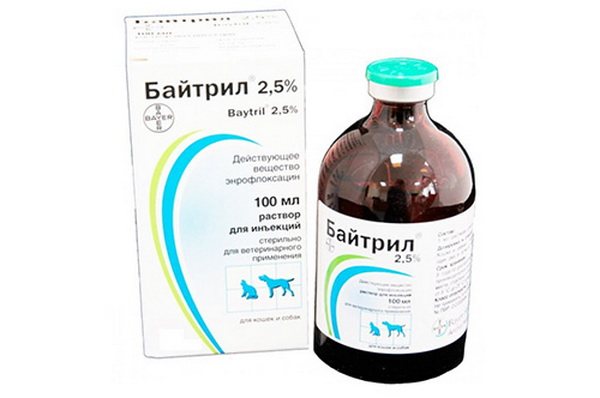

The dosage of Baytril depends on the weight and age of the animal. Adult rabbits are injected with 5 mg of the substance, cubs - from 1 to 2 mg once a day. Do not administer Baytril injections to pregnant rabbits and newly born rabbits. It is better for them to choose another drug. This medicine is safe for adults.
Side effects and contraindications
According to GOST, the agent is classified as low-toxic, therefore, with the correct use of the drug, side effects do not occur. In rare cases, individual intolerance is possible in a small number of birds - less than 5%, as well as a slight weight loss after a course of treatment.
Veterinarians do not recommend giving Amprolium for such categories of birds:
- replacement young growth at the age of 16 weeks;
- layers.
If the dosage is exceeded, birds may develop polyneuritis.
When is it used?
The main purpose of the veterinary drug Amprolium is the treatment of coccidiosis. This disease affects individuals with low immunity, and therefore pregnant, lactating females and young animals are susceptible to infection. The disease leads to exhaustion of rabbits, anemia, accompanied by indigestion. In the absence of therapy, coccidiosis leads to the death of animals.
This drug is also used for other ailments as part of complex therapy:
The medicine is intended not only for the treatment of coccidiosis, but also for its prevention. It is important to study the instructions before use, since prophylactic and therapeutic dosages differ.
Rabbit after vaccination against coccidiosis
Warnings and special instructions
When working with Amprolium, precautions and certain rules regarding the slaughter of birds should be observed:
- The birds should be sent for meat 7 days after the last meal. If the poultry was slaughtered earlier, then the carcasses are used as feed for unproductive animals.
- When using the product, wear protective clothing and gloves. It is forbidden to drink, smoke or eat food while preparing or giving the medicine.
- After working with the product, wash your hands with soap and rinse your mouth with fresh water.
- It is strictly forbidden to use empty containers for storing food products and other preparations.
What other drugs are there for rabbit coccidiosis?
In addition to Amprolium, other drugs are also used against coccidiosis. Below is a list of coccidiostatic analogs:
Aymeterm - an analogue of the drug
- Eimeterm;
- Baytril;
- Tolucox;
- Zinaprim.
Eimeterm
Eimeterm 5% is a coccidiostatic suspension. The active ingredient is toltrazuril. 1 ml of the drug contains 50 mg of the active substance, which quickly blocks the enzymes responsible for the course of metabolic processes in the cells of the simplest microorganisms. Toltrazuril prevents the reproduction of coccidia and causes their death.
Before starting treatment, you need to correctly calculate the dose of medicine for the rabbit.For 1 kg of animal weight, 0.14 ml of the suspension is measured. If the animal is 4 kg, then he is given 0.56 ml of the product. Eimeterm is administered orally. A single dose is enough to completely rid the rabbit of parasites. In severe cases, Eimeterm is given twice with an interval between doses of 5 days.
Attention! Do not slaughter rabbits treated with Eimeterm earlier than 70 days after taking the suspension, since their meat is unsuitable for food.
Baytril
Baytril is an antibacterial agent that is also effective against coccidia. It is available in the form of a liquid solution at a concentration of 5% and 10%. The first option is used for injection, and the second is orally.
For the treatment of rabbits, the agent is diluted in water according to the instructions - 5 ml of the agent is taken for 10 liters. The course of treatment lasts 3 days.
Attention! The slaughter of animals is allowed to be carried out no earlier than 14 days after the last intake of the drug.
Tolucox
The active ingredient in Tolucox is toltrazuril. The product is available in the form of a suspension. Veterinarians recommend it to animals in which the disease progresses, and other drugs are ineffective.
The scheme for taking Tolucox for rabbits is as follows - 1 ml of the suspension is dissolved in half a liter of water and the drinkers are filled with it. The prepared composition is used for 2 days, after which the treatment is suspended for 5 days. Next, a fresh solution is prepared and the rabbits are watered again for 2 days.
Attention! Slaughter of rabbits treated with Tolucox can be carried out after 8 days.
Zinaprim
Zinaprim is presented in veterinary pharmacies in two forms - in the form of a solution for injection and a powder. In its composition, it contains 2 components that have a detrimental effect on coccidia:
Each of the components enhances the action of the other. In general, the drug is well tolerated, but if the doses indicated in the instructions are exceeded, it can cause vomiting or diarrhea in rabbits.
How to use the solution for rabbits:
- the dosage is calculated based on the body weight of the animal - 1 ml of the composition is taken per 10 kg of weight;
- Zinaprim is administered intramuscularly;
- on the first day, the agent is administered twice with an interval of 12 hours;
- on the following days of treatment, 1 injection is given in the morning or in the evening;
- the duration of the course of therapy is determined by the veterinarian.
Zinaprim in the form of a powder is dissolved in drinking water in a proportion of 1 g / 1 l. The drinker is filled with drink. The next day, a solution is prepared with a lower drug concentration - 0.5 g / 1 l. The drinking bowl is filled with water every day. During treatment, pets should not be given clean drinking water, except for the one that contains medicine. The duration of therapy is from 3 to 5 days.
Coccidiosis causes serious damage to farms, as the infection spreads rapidly and affects all rabbits. This disease is especially dangerous for young animals. To protect animals from the simplest parasites, veterinary drugs are used - Amprolium and its analogues. First, you need to carefully study the instructions for using the medication and consult a veterinarian about the duration of the course of treatment and dosage, so as not to harm the pets.
Most experienced farmers know that rabbits are exposed to diseases, especially infectious ones, quite often. Maintaining their health is a key task for the owner, as otherwise there can be deaths and the infection spreads quickly. One of the most dangerous parasitic diseases is coccidiosis, its treatment with the help of the drug "Amprolium" and others will be discussed in this article.
Terms and conditions of storage
Manufacturers recommend storing Amprolium in a dry place out of the reach of children, pets and sunlight. Storage temperature - up to 25 ℃. It is forbidden to keep the medicine near food, drinks and animal feed. The tool can be used within two years from the date of production. If the drug was diluted in water, then the solution should be used within 24 hours. The medicine mixed with dry food can be stored for a week.
Amprolium is an effective and harmless preparation for birds, which helps to strengthen the immune system, does not cause addiction and effectively fights coccidiosis. When using the product, you must strictly follow the instructions, adhere to the recommendations and take precautions.
What is Amprolium?
The drug has a 4 safety level and is practically non-toxic. About 97% of the total substance is excreted along with feces, the rest is digested and excreted in the urine. When used in recommended doses, it does not cause any side effects, since it is practically not absorbed into the intestines, and, accordingly, into the bloodstream.
This effect is characterized by a similar chemical structure to thiamine. Vitamin B1 is an extremely important part of the life and reproduction of coccidia. Due to the similarity, the drug penetrates into the parasitic cell. Then inside it takes a place intended for the absorption of vitamins and disrupts the metabolism in bacteria, due to the parasitic infection dies.
Pulvis zinaprim
Index | Preparations by manufacturer | Disease Drugs | Search
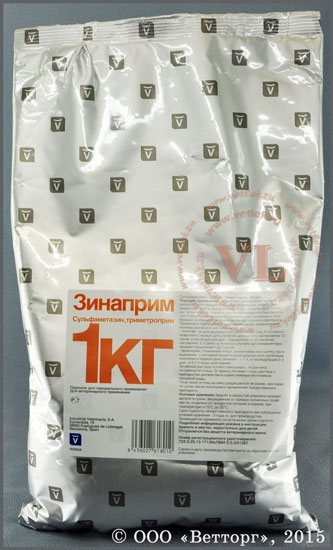

Name ZINAPRIM POWDER Name (lat.) Pulvis Zinaprim Composition and release form Antibacterial preparation containing sulfamethazine and trimethoprim as active ingredients. 1 g of the drug contains 200 mg of sulfamethazine and 40 mg of trimethoprim. The drug in appearance is a fine white-yellow powder. Produced in foil packs of 0.5 - 5 kg. Pharmacological properties Sulfamethazine and trimethoprim, which are part of the drug, separately act on the microbial cell bacteriostatically, and together they show synergistic action, that is, they enhance the action of each other. The bactericidal effect of zinaprim is due to the sequential blockade of enzymes in the microbial cell: sulfamethazine disrupts the synthesis of dihydrofolic acid, and trimethoprim blocks the next stage of bacterial metabolism - the reduction of dihydrofolic acid to tetrahydrofolic acid, which is necessary for the development of microorganisms. The drug has a wide spectrum of action against gram-negative and gram-positive microorganisms, including Clostridium spp., E. Coli, Salmonella spp., Haemophilus spp., Pasteurella spp., Proteus mirabilis, Streptococcus spp. The antibacterial components of zinaprim are well absorbed from the gastrointestinal tract and are quickly distributed to all organs and tissues of the body. Sulfamethozin and trimethoprim are excreted mainly in the urine and, to a lesser extent, in the bile. Indications Treatment of bacterial diseases of cattle, sheep, goats, pigs, horses, dogs, cats, rabbits and poultry, localized in the gastrointestinal tract, respiratory tract, genitourinary system, caused by microorganisms sensitive to the combination of trimethoprim-sulfanilamide. Doses and method of administration The drug is administered orally once a day: to cattle, sheep, goats and small animals at a dose of 1 g per 10 kg of body weight for 3 - 5 days. It is possible to use zinaprim with water at the rate of 750 g per 1000 liters of drinking water. On the first day, it is recommended to enter a therapeutic dose twice with an interval of 12 hours. Zinaprim is applied to poultry and rabbits in a dose of 1 g per liter of drinking water on the first day, in the next 2 to 3 days the daily dose is 0.5 g per 1 liter of drinking water. During the treatment period, the bird receives only water containing zinaprim. Side effects Not observed in recommended doses. With an increase in the period of use, vomiting, diarrhea, crystalluria may appear. Contraindications Individual hypersensitivity to one of the drug components
It should be administered with caution to animals with renal and hepatic insufficiency. Special instructions Slaughter for meat is allowed 5 days after the last use of the drug. Meat of animals that were forcedly killed before the expiration of the specified period can be used to feed fur-bearing animals or for the production of meat and bone meal
It is forbidden to use milk obtained from animals for food purposes during the period of treatment with the drug and within 4 days after stopping the use of the drug. Storage conditions List B. In a dry, dark place at a temperature of 5 to 25 ° C. The shelf life is 5 years. Manufacturer INVESA, Spain Seller Your ad place
Contraindications for use
The drug does not cause side effects, there is no mention of such cases, but some contraindications still exist:
- Intolerance or hypersensitivity to the drug;
- Diseases associated with obstructed passage of feces and urine, especially kidney and liver diseases;
- When replacement chicks have reached 16 weeks of age or more;
- Particular care is required when using furan group drugs with antibiotics or antioxidiotics.
An overdose study has shown the drug is safe, with the only side effect being a slower crawl growth.

